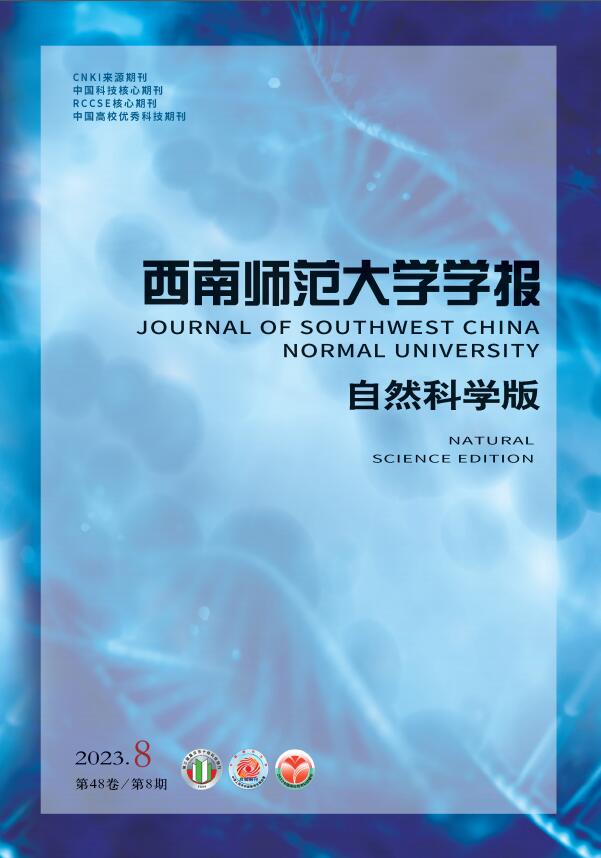-
本文研究如下一类Kirchhoff型方程组:
其中Ω是
$\mathbb{R}$ N中的光滑区域,N≤3,V(x)是位势函数,ai,bi,λi,μi(i=1,2)是正数,k,β是耦合项系数. 为了研究方程组(1)解的存在性,假定位势函数V(x)连续且满足如下条件:(V1)
$\underset{x \in {\mathbb{R}^N}}{\sup }$ V(x)=$\lim\limits_{|x| \rightarrow \infty}$ V(x)=Λ>0;(V2)
$\underset{x \in {\mathbb{R}^N}}{\inf }$ V(x)≥0.方程组(1)中u和v表示位移,bi是初始张力,而ai与弹性弦的固有性质有关[1].如果V≡0,那么方程组(1)变为
如果v≡0,k=0,β=0,那么方程组(2)可以化简为如下Kirchhoff型方程:
方程(3)是文献[2]首次提出的,用来描述弹性弦的自由振荡问题. 随后,文献[3]用变分法研究了Kirchhoff型方程,很多学者也对此产生兴趣,获得了一些重要成果[4-7]. 对于不含非局部项的相关结果可参见文献[8-10].
由于存在非局部项∫Ω|▽u|2dx和∫Ω|▽v|2dx等,方程组(1)-(2)以及方程(3)都被称为非局部问题. 如果没有非局部项,方程组(2)可以转化为非线性Schrödinger方程组
文献[11]用Nehari流形证明了方程组(4)基态解的存在性.k=0时的一些成果见文献[12-16].
近年来,一些学者开始关注Kirchhoff型方程组解的存在性问题[17-20]. 文献[17]研究了小正参数对具有耦合项的Kirchhoff型方程组解的存在性和多解性的影响;文献[18]研究了一类临界的和次临界的情形下Kirchhoff型方程组解的存在性和多解性;文献[19]讨论了具有耦合项的非线性Kirchhoff型方程组正向量解的存在性和渐近性;文献[20]采用新的方法更加方便地证明了自治Kirchhoff型方程或方程组解的存在性. 与上述文献不同,本文研究了一类具有线性和非线性耦合项的Kirchhoff型方程组(1)和(2)解的存在性问题,而且证明了变号解的存在性. 在本文的研究中需要克服两个困难,其一是对两个非局项的处理,其二是证明PS序列的收敛性. 首先研究方程组(2). 用Nehari流形得到了PS序列. 如果Ω有界,用Sobolev嵌入定理证明了基态解的存在性;如果Ω=
$\mathbb{R}$ N,运用Lions紧性引理证明了基态解的存在性. 应注意到,尽管受到文献[11]的启发,但是由于非局部项∫Ω|▽u|2dx和∫Ω|▽v|2dx的存在,文献[11]的方法不能直接应用于我们的问题,需要更加细致的工作. 之后,研究方程组(1),我们得到了方程组(1)解的存在性.
定理1 设Ω是
$\mathbb{R}$ N中的光滑有界区域或者Ω=$\mathbb{R}$ N,β∈$\mathbb{R}$ ,k∈(-$\sqrt{\lambda_{1} \lambda_{2}}$ ,0)∪(0,$\sqrt{\lambda_{1} \lambda_{2}}$ ),那么方程组(2)存在一个基态解(u,v).另外,若k∈(-$\sqrt{\lambda_{1} \lambda_{2}}$ ,0),那么u>0,v>0;若k∈(0,$\sqrt{\lambda_{1} \lambda_{2}}$ ),那么u>0,v < 0,或者u < 0,v>0.定理2 设Ω=
$\mathbb{R}$ N,β∈(-$\sqrt{\mu_{1} \mu_{2}}$ ,+∞),k∈(-$\sqrt{\lambda_{1} \lambda_{2}}$ ,0)∪(0,$\sqrt{\lambda_{1} \lambda_{2}}$ ). 若条件(V1)-(V2)成立,那么方程组(1)存在一个基态解(u,v). 另外,若k∈(-$\sqrt{\lambda_{1} \lambda_{2}}$ ,0),那么u>0,v>0;若k∈(0,$\sqrt{\lambda_{1} \lambda_{2}}$ ),那么u>0,v<0,或者u<0,v>0.
HTML
-
若N>2,记2*=
$\frac{2 N}{N-2}$ ;若N=1,2,记2*=∞.定义C1,C2,C3,C4>0.若Ω⊆$\mathbb{R}$ N是光滑区域,在H1(Ω)×H1(Ω)上定义内积和范数
-
假定ai,bi,λi,μi>0,i=1,2,β∈
$\mathbb{R}$ ,k∈(-$\sqrt{\lambda_{1} \lambda_{2}}$ ,0)∪(0,$\sqrt{\lambda_{1} \lambda_{2}}$ ).若Ω是$\mathbb{R}$ N中的光滑有界区域,设若Ω=
$\mathbb{R}$ N,设定义
$\mathscr{H}$ 上的内积如(5)式,范数如(6)式.对∀(u,v)∈$\mathscr{H}$ ,设方程组(2)的能量泛函为其中L(s)=∫Ω|▽s|2dx. 设
令
易知,方程组(2)的非平凡解(u,v)∈
$\mathscr{N}$ .下面先证明方程组(2)存在一个半平凡解,从而可得$\mathscr{N}$ ≠Ø.引理1[18] 设方程(3)的泛函为Iλ1(u).设
$\mathcal{N}_{{\mathit{\lambda}}_{1}}$ ={u∈H01(Ω)\{0}:〈I′λ1(u),u〉=0}. 通过讨论极小化问题$\inf\limits_{u \in \mathscr{N}_{{\mathit{\lambda}}_{1}}}$ (u),证得方程(3)存在一个正解.如果Ω=
$\mathbb{R}$ N,a1=1,b1=0,则方程(3)可以简化为引理2[20] 如果方程(7)有唯一解Q(x),且代数方程M(cN-2||Q||2)=c2有唯一正根c||Q||2*,其中M:
$\mathbb{R}$ +→$\mathbb{R}$ +是一个映射,那么u(x)∈{${Q\left({\frac{x}{{c_{||Q||{^2}}^*}} + t} \right)}$ :t∈$\mathbb{R}$ N}是方程(3)的唯一解.注1 若|Ω| < ∞,由引理1知方程组(2)存在一个半平凡解;若Ω=
$\mathbb{R}$ N,由引理2知方程组(2)存在一个半平凡解. 无论哪种情形,方程组(2)都存在一个半平凡解,于是得到$\mathscr{N}$ ≠Ø.引理3
$\mathscr{N}$ 是$\mathscr{H}$ 的一个光滑子流形.证 对∀(u,v)∈
$\mathscr{N}$ ,易见,引理3成立.
引理4 对∀(u,v)∈
$\mathscr{N}$ ,$\left.I\right|_{\mathcal{N}}(u, v)$ =$\frac{1}{4}$ ||(u,v)||2.并且存在正数C1>0,使得对∀(u,v)∈$\mathscr{N}$ ,||(u,v)||≥C1>0.证 若(u,v)∈
$\mathscr{N}$ ,那么即
因此,对∀(u,v)∈
$\mathscr{N}$ ,由Sobolev嵌入定理得
既然||(u,v)||≠0,那么存在C1>0,使得对∀(u,v)∈
$\mathscr{N}$ ,||(u,v)||≥C1>0.引理5 若(u,v)是
$\left.I\right|_{\mathscr{N}}$ 的临界点,那么(u,v)也是I的临界点.证 若(u,v)是
$\left.I\right|_{\mathscr{N}}$ 的临界点,那么I′(u,v)=η$\mathscr{J}'$ (u,v),其中η∈$\mathbb{R}$ 是一个Lagrange乘子.于是由(8)式和(9)式得η=0.引理5成立.
引理6 若{(un,vn)}⊆
$\mathscr{H}$ 是$\left.I\right|_{\mathscr{N}}$ 的PS序列,那么{(un,vn)}是I的PS序列. 而且,若Ω有界,那么存在(u,v)∈$\mathscr{N}$ ,使得{(un,vn)}在$\mathscr{H}$ 上有一个收敛于(u,v) 的子列.证 不妨假定
$\left\{I\left(u_{n}, v_{n}\right)\right\}$ 有界, 则$\left.I\right|_{\mathscr{N}} ^{\prime}\left(u_{n}, v_{n}\right) \rightarrow 0$ . 再由引理4得,$\left\{\left(u_{n}, v_{n}\right)\right\}$ 在$\mathscr{H}$ 上有界. 从而, 存在$(u, v) \in \mathscr{H}$ , 使得$\left(u_{n}, v_{n}\right) \rightarrow(u, v)$ . 若Ω有界, 则在$L^{4}({\mathit{\Omega}}) \times L^{4}({\mathit{\Omega}})$ 上$\left(u_{n}, v_{n}\right) \rightarrow(u, v)$ . 于是存在序列$\left\{\eta_{n}\right\} \subseteq$ $\mathbb{R}$ , 使得那么
由(8)式和引理4得〈
$\mathscr{J}'$ (un,vn),(un,vn)〉≤-C4. 因此ηn=o(1). 既然{(un,vn)}有界,那么{$\mathscr{J}'$ (un,vn)}有界. 因此,当n→∞时,因为I′(un,vn)→0和(un,vn)
$⃑$ (u,v),那么I′(u,v)=0和$\mathscr{J}$ (u,v)=0. 若Ω有界,那么因此(un,vn)→(u,v)∈
$\mathscr{H}$ . 由引理4得||(u,v)||2≥C12,即(u,v)≠(0,0). 那么(u,v)∈$\mathscr{N}$ .设
若Ω有界,由Sobolev紧嵌入定理,c1和c2是存在的.或者若Ω=
$\mathbb{R}$ N,由集中紧性原理可得c1和c2是存在的.由引理4得定理1的证明 由c>0和文献[11]的引理2.2,存在某个序列{(un,vn)}⊆
$\mathscr{N}$ ,使得{(un,vn)}是$\left.I\right|_{\mathscr{N}}$ 的(PS)c序列. 因此,由引理6得{(un,vn)}是I的(PS)c序列. 根据对Ω的假定,拟分两种情形讨论方程组(2)解的存在性.情形1 假设Ω有界. 由引理6,考虑其子列,存在(u,v)∈
$\mathscr{N}$ ,在$\mathscr{H}$ 上,(un,vn)→(u,v). 因此,I′(u,v)=0和I(u,v)=c.情形2 假定Ω=
$\mathbb{R}$ N.若$\liminf\limits_{n \rightarrow \infty}\sup\limits_{x \in \mathbb{R}^N}$ ∫B1(x)un2(y)dy=0和$\liminf\limits_{n \rightarrow \infty}\sup\limits_{x \in \mathbb{R}^N}$ ∫B1(x)vn2(y)dy=0,那么,由文献[21]中的引理1.21得,在L4($\mathbb{R}$ N)×L4($\mathbb{R}$ N)上(un,vn)→(0,0). 因此,当n→∞时,设A=
$\lim\limits_{n \rightarrow \infty} \int_{\mathbb{R}^{N}}$ |▽un|2dx和B=$\lim\limits_{n \rightarrow \infty} \int_{\mathbb{R}^{N}}$ |▽vn|2dx,那么,当n→∞时,与||(un,vn)||2≥C12相矛盾. 所以,不失一般性,存在一个正数α,使得
$\liminf\limits_{n \rightarrow \infty}\sup\limits_{x \in \mathbb{R}^N}$ ∫B1(x)un2(y)dy=α.考虑其子列,可假定存在某个序列{xn}⊆$\mathbb{R}$ N,使得由引理4有
则{(un(· -xn),vn(· -xn))}有界. 取某个子列,对某些(u,v)∈
$\mathscr{H}$ ,在$\mathscr{H}$ 上,(un(· -xn),vn(· -xn))$⃑$ (u,v);在Lloc2($\mathbb{R}$ N)×Lloc2($\mathbb{R}$ N)上,(un(· -xn),vn(· -xn))→(u,v). 由(14)式得∫B1(0)u2(y)dy≥$\frac{\alpha}{2}$ ,这表明u≠0.因为$\mathscr{N}$ 是平移不变的,故{(un(· -xn),vn(· -xn))}∈$\mathscr{N}$ . 类似地,可得||un(· -xn),vn(· -xn)||2=||(un,vn)||2,和I(un(· -xn),vn(· -xn))=I(un,vn). 则||I′(un(· -xn),vn(· -xn))||=||I′(un,vn)||. 因此{(un(· -xn),vn(· -xn))}是I的(PS)c序列. 那么I′(u,v)=0,$\mathscr{J}$ (u,v)=0. 在上述讨论中知u≠0,则(u,v)∈$\mathscr{N}$ .由范数的弱下半连续性和(10)式得故有I(u,v)=c. 综上所述,在两种情形下都有(u,v)∈
$\mathscr{N}$ ,I(u,v)=c,I′(u,v)=0. 因此,u≠0和v≠0. 接下来,讨论k取不同范围值时,u和v的符号.首先,设k<0.则
由
$\mathscr{J}$ (u,v)=0得对t≥0,定义一个C1函数φ(t)=I(t|u|,t|v|),即
令t0=
$\frac{\|(|u|, |v|)\|}{\|(u, v)\|}$ ∈(0,1].显然,φ(t)在(0,t0)上严格单调递增,在(t0,+∞)上严格单调递减. 另外,注意到(t0|u|,t0|v|)∈$\mathscr{N}$ . 由(10)式得因此,||(|u|,|v|)||2=||(u,v)||2,(|u|,|v|)∈
$\mathscr{N}$ ,I(|u|,|v|)=c. 不失一般性,可假设u≥0,v≥0. 由引理5知,(u,v)是I的一个临界点. 因此(u,v)是方程组(2)的一个基态解.由椭圆正则性定理知,||u||L∞<+∞,||v||L∞<+∞. 由于(u,v)是方程组(2)的解,即
那么,由最大值原理知
再者,设k>0. 由上述类似的讨论,易知||(|u|,-|v|)||2=||(u,v)||2,(|u|,-|v|)∈
$\mathscr{N}$ ,I(|u|,-|v|)=c. 因此,不妨设u≥0和v≤0. 由引理6知,(u,v)是I的一个临界点. 因此,(u,v)是方程组(2)的一个基态解. 与(16)式的证明类似,由椭圆正则原理和最大值原理得u>0,v < 0.命题1 若k∈(-
$\sqrt{\lambda_{1} \lambda_{2}}$ ,0)∪(0,$\sqrt{\lambda_{1} \lambda_{2}}$ ),则c<min{c1,c2}.证 由注1知,存在u1>0和v1>0,使得(u1,0),(0,v1)∈
$\mathscr{N}$ ,c1=I(u1,0),c2=I(0,v1). 因此设g(t,s)=
$\mathscr{J}$ (tu1,tsv1). 显然由函数g的光滑性和隐函数存在定理知,存在一个足够小的正数s0和函数t(s)∈
$\mathscr{C}$ 1(-s0,s0),使得对s∈(-s0,s0),t(0)=1,g(t(s),s)=0,t′(s)=-$\frac{g_{s}(t, s)}{g_{t}(t, s)}$ .从而,(t(s)u1,t(s)sv1)∈$\mathscr{N}$ ,并且t′(0)=$\frac{k \int_{{\mathit{\Omega}}} u_{1} v_{1} \mathrm{~d} x}{\int_{{\mathit{\Omega}}}\left(a_{1}\left|\nabla u_{1}\right|^{2}+\lambda_{1} u_{1}^{2}\right) \mathrm{d} x}$ . 设α=t′(0),则因此,对∀s∈(-s0,s0),有
当k∈(-
$\sqrt{\lambda_{1} \lambda_{2}}$ ,0)时,存在s>0和s≪1,使得sk∫Ωu1v1dx+o(s)<0. 那么c<c1. 类似地,当k∈(0,$\sqrt{\lambda_{1} \lambda_{2}}$ )时,亦有c<c1. 总之,当k∈(-$\sqrt{\lambda_{1} \lambda_{2}}$ ,0)∪(0,$\sqrt{\lambda_{1} \lambda_{2}}$ )时,c<c1. 同理,当k∈(-$\sqrt{\lambda_{1} \lambda_{2}}$ ,0)∪(0,$\sqrt{\lambda_{1} \lambda_{2}}$ )时,c<c2. 于是可得命题1的结论.
-
假定β∈(-
$\sqrt{\mu_{1} \mu_{2}}$ ,+∞),k∈(-$\sqrt{\lambda_{1} \lambda_{2}}$ ,0)∪(0,$\sqrt{\lambda_{1} \lambda_{2}}$ ),位势函数V(x)满足条件(V1)-(V2). 若V(x)≡Λ,那么方程组(1)可以转化为方程组(2). 故假定V(x)≢Λ. 定义空间V=H1($\mathbb{R}$ N)×H1($\mathbb{R}$ N),其内积为范数为||(u,v)||V=((u,v),(u,v))
$^{\frac{1}{2}}$ .方程组(1)的极限情形是
设方程组(1)的能量泛函为
类似地,定义方程组(17)的能量泛函为
设
定义Nehari流形
定义cV=
$\inf\limits_{(u, v) \in \mathcal{N}_{V}}$ IV(u,v),其中cΛ和第2节中的c有关,只需将λ1,λ2替代为λ1+Λ,λ2+Λ.引理7 假定V(x)满足条件(V1)-(V2),那么cV<cΛ.
证 设β>-
$\sqrt{\mu_{1} \mu_{2}}$ .由文献[21]的章节4,定义cV=$\mathop {\inf }\limits_{r \in \mathit{\Gamma }} \mathop {\max }\limits_{t \in \left[{0, 1} \right]}$ IV(γ(t)),其中设(u,v)为方程组(17)的基态解. 因为V(x)≤Λ,V(x)≢Λ,u≠0,v≠0,那么存在正数t0,使得
故有cV<cΛ.
接下来,我们将用集中紧性原理和引理7证明定理2.
定理2的证明 类似于(13)式的证明,有cV>0. 由文献[11]的引理2.2知,存在某个序列{(un,vn)}⊆
$\mathscr{N}_V$ ,使得{(un,vn)}是$I_{V}||_{\mathcal{N}_{V}}$ 的(PS)cV序列.类似于引理5,{(un,vn)}是IV的(PS)cV序列. 显然地,{(un,vn)}有界. 考虑其子列,存在(u,v)∈H1($\mathbb{R}$ N)×H1($\mathbb{R}$ N),使得在H1($\mathbb{R}$ N)×H1($\mathbb{R}$ N)上(un,vn)$⃑$ (u,v).运用反证法和定理7,可证得u≠0或v≠0.下面类似于定理1的证明,可分Ω为有界区域以及Ω=$\mathbb{R}$ N两种情形证明(u,v)是方程组(1)的基态解,同时还可如定理1那样,依据k的符号讨论u以及v的符号,从而可得定理2的结论.






 DownLoad:
DownLoad: